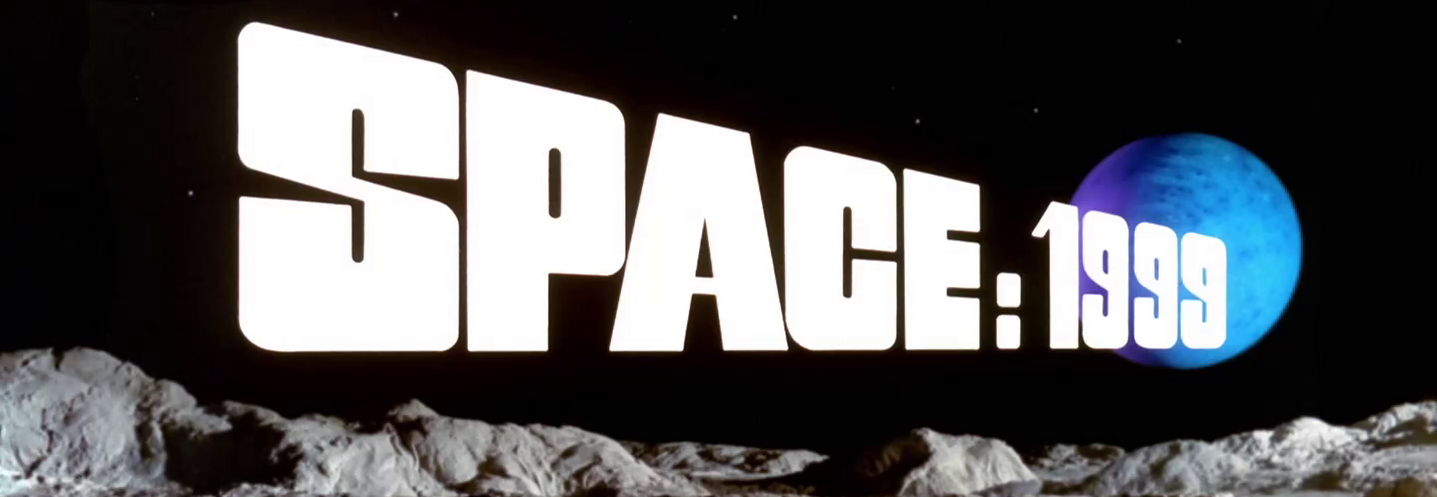- Breakaway
- Force Of Life
- Collision Course
- War Games
- Death’s Other Dominion
- Voyager’s Return
- Alpha Child
- Dragon’s Domain
- Mission Of The Darians
- Black Sun
- Guardian Of Piri
- End Of Eternity
- A Matter Of Life And Death
- Earthbound
- The Full Circle
- Another Time, Another Place
- The Last Sunset
- The Troubled Spirit
- The Infernal Machine
- Ring Around The Moon
- Missing Link
- Space Brain
- The Testament Of Arkadia
- The Last Enemy
- The Metamorph
- The Exiles
- Journey To Where
- One Moment Of Humanity
- Brian The Brain
- New Adam, New Eve
- The Mark Of Archanon
- The Rules Of Luton
- All That Glisters
- The Taybor
- Seed Of Destruction
- AB Chrysalis
- Catacombs Of The Moon
- Space Warp
- A Matter Of Balance
- The Beta Cloud
- The Lambda Factor
- The Bringers Of Wonder – Part 1
- The Bringers Of Wonder – Part 2
- The Seance Spectre
- Dorzak
- Devil’s Planet
- The Immunity Syndrome
- The Dorcons
- Message From Moonbase Alpha
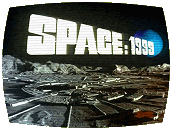 Season One: 1975-76
Season One: 1975-76
Epilogue
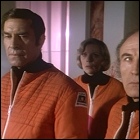 Originally conceived as the second season of puppet pioneer Gerry Anderson’s live action series UFO, Space: 1999 stands out as one of the few major space-based SF series of the mid 1970s, and possibly the very first such series to be co-produced internationally, a path later followed by such series as Farscape and Lexx. In the original outline, having beaten the alien invasion back into space, the heroes of UFO would have pursued them into deep space by transforming Earth’s moon into a huge spacecraft. When UFO didn’t make the ratings dent internationally that ITC had hoped for,
Originally conceived as the second season of puppet pioneer Gerry Anderson’s live action series UFO, Space: 1999 stands out as one of the few major space-based SF series of the mid 1970s, and possibly the very first such series to be co-produced internationally, a path later followed by such series as Farscape and Lexx. In the original outline, having beaten the alien invasion back into space, the heroes of UFO would have pursued them into deep space by transforming Earth’s moon into a huge spacecraft. When UFO didn’t make the ratings dent internationally that ITC had hoped for, 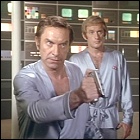 it pulled the plug on the second season. Gerry Anderson kept developing the idea independent of the UFO storyline, originally titling it 1999 and finally Space: 1999.
it pulled the plug on the second season. Gerry Anderson kept developing the idea independent of the UFO storyline, originally titling it 1999 and finally Space: 1999.
The basic plot Anderson developed involved a peacetime manned moon colony struggling to survive after a massive collision bumps the moon out of Earth’s orbit and sends it plunging into deep space. The cinematic antecedent of Space: 1999 was 2001: a space odyssey – as realistic as possible in its special effects and model work (in 1976, a young director named George Lucas tried to headhunt special effects supervisor Brian Johnson from Space: 1999 to work on his effects-heavy, behind-schedule sci-fi film called Star Wars, but was turned down), and as scientifically accurate as possible. Nevertheless, when it premiered, the series’ much-advertised 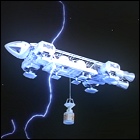 accuracy was neatly shredded in a now-famous newspaper article penned by none other than Isaac Asimov, who still gracefully admitted that some things needed to be given dramatic license for the audience’s benefit. Still, scientific accuracy aside, the first series featured the most impressive effects work to grace a television SF series up to that point, and generally presented a somewhat bleak, angst-ridden story.
accuracy was neatly shredded in a now-famous newspaper article penned by none other than Isaac Asimov, who still gracefully admitted that some things needed to be given dramatic license for the audience’s benefit. Still, scientific accuracy aside, the first series featured the most impressive effects work to grace a television SF series up to that point, and generally presented a somewhat bleak, angst-ridden story.
Future Academy Award winner Martin Landau and his then-wife Barbara Bain – both fresh from Paramount’s hit Mission: Impossible – headed up the series, with Landau in particular occasionally hamming it up to near-Shatnerian heights. Both actors had it written into their 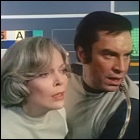 contracts that they would receive a lion’s share of the screen time per episode (with no less than an agreed-upon amount of time), necessitating the rewriting of several early scripts (and later created some awkward scene-shuffling when Catherine Schell was introduced to the cast in the second season). In fact, the opening titles for the first season credited Landau and Bain before the Space: 1999 title ever appeared.
contracts that they would receive a lion’s share of the screen time per episode (with no less than an agreed-upon amount of time), necessitating the rewriting of several early scripts (and later created some awkward scene-shuffling when Catherine Schell was introduced to the cast in the second season). In fact, the opening titles for the first season credited Landau and Bain before the Space: 1999 title ever appeared.
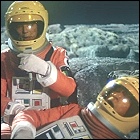 For the second season, ITC wanted more action and adventure, and less angst. Fred Freiberger, the controversial producer whose influence was felt very distinctly on the oft-criticized third (and final) season of Star Trek, was brought in to oversee the show’s transformation, introducing British actress Catherine Schell as Maya and making the show’s uniforms, environs and aliens far more colorful (somewhat similar to the near-psychedelic treatment Freiberger inflicted upon
For the second season, ITC wanted more action and adventure, and less angst. Fred Freiberger, the controversial producer whose influence was felt very distinctly on the oft-criticized third (and final) season of Star Trek, was brought in to oversee the show’s transformation, introducing British actress Catherine Schell as Maya and making the show’s uniforms, environs and aliens far more colorful (somewhat similar to the near-psychedelic treatment Freiberger inflicted upon 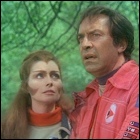 Star Trek). The show was less heavy – but also less concerned with addressing the show’s ongoing storyline or scientific accuracy. At the end of the second year, Space: 1999 was cancelled.
Star Trek). The show was less heavy – but also less concerned with addressing the show’s ongoing storyline or scientific accuracy. At the end of the second year, Space: 1999 was cancelled.
Thanks to reruns, both in syndication and on PBS, Space: 1999 built up a healthy fan cult in America and overseas. In 2000, Johnny Byrne – who served as script editor and head writer during the first season – wrote and produced a short fan-made film, using costumes and set pieces from the original series and featuring original cast member Zienia Merton, reprising her role as Moonbase Alpha communications specialist Sandra Benes, giving a brief narration of 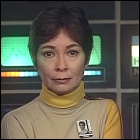 what has happened to the crew – and setting up Byrne’s ideas for a spinoff or sequel series. This short film, incorporating montages of footage from the series, was shown at conventions and was also included in the French DVD edition of the series as well as the full-series US DVD box set; vigorous fan campaigning continues for a release of Message in the UK.
what has happened to the crew – and setting up Byrne’s ideas for a spinoff or sequel series. This short film, incorporating montages of footage from the series, was shown at conventions and was also included in the French DVD edition of the series as well as the full-series US DVD box set; vigorous fan campaigning continues for a release of Message in the UK.
In 2012, ITV – now the rights holders to ITC/Carlton’s library of intellectual properties – announced that it was setting the wheels in motion for a “reimagining” of Space: 1999, now set a century further in the future and retitled Space: 2099 (unrelated to a 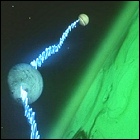 stillborn fan film project of the same name which had been mooted by Star Trek: New Voyages co-founder Jack Marshall). Many of the creative forces behind the 21st century remake of V will be behind the new voyages of Moonbase Alpha, and the series is being tailored with a careful eye on the American market – the same goal that has stopped many prior Gerry Anderson live-action projects in their tracks.
stillborn fan film project of the same name which had been mooted by Star Trek: New Voyages co-founder Jack Marshall). Many of the creative forces behind the 21st century remake of V will be behind the new voyages of Moonbase Alpha, and the series is being tailored with a careful eye on the American market – the same goal that has stopped many prior Gerry Anderson live-action projects in their tracks.


